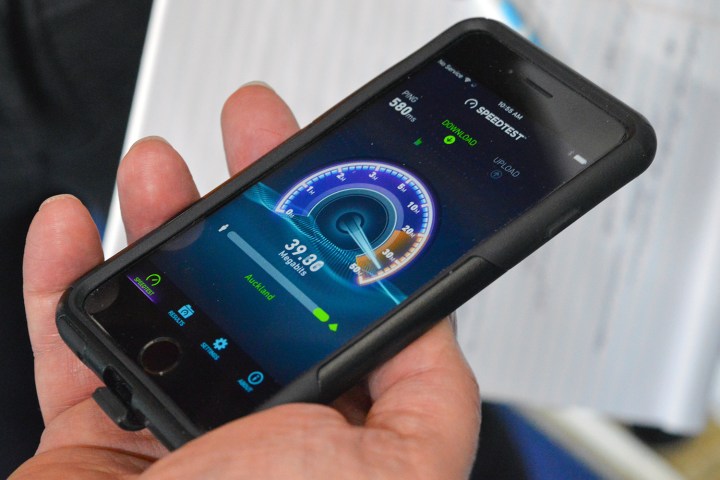With the growth in the internet of things (IoT), there is rarely a moment when we aren’t connected. Air travel used to be a time when we had to turn our tech off, but no more: planes, too, are becoming a node in the IoT.
However, if you’re a frequent traveler you’ve likely experienced the pain that is inflight Wi-Fi — even on the most cutting-edge airlines. You get in the air, find out there’s internet access, pay the unworldly fee, and you’re supposedly good to go. We say supposedly because inflight Wi-Fi is famously slow and spotty, and while some are advertised as high-speed, you are restricted from using streaming services like Netflix, Spotify, and HBO Go. Although it’s definitely a feat of engineering that there’s internet in a plane at all, it could use some work. And that’s where Honeywell is stepping in.
Last week, in San Francisco, we had the opportunity to check out what Honeywell has been working on in the way of in-flight internet connections, and we were pleasantly surprised. The company is conducting a worldwide tour on a 757 “Connected Aircraft,” and it’s demonstrating its satellite-based inflight Wi-Fi concept in partnership with Boeing and GX Aviation (the Wi-Fi services arm of satellite communications company, Inmarsat, which counts Air New Zealand, Lufthansa, and Qatar Airways as customers).
“You’ve got to be able to connect in-flight, even through conditions that are tough on a satellite receiver.”
Using satellites for broadband internet isn’t new — the concept dates back to 2000 when Boeing launched its now-defunct Connexion service, and, today, it can be found on planes serviced by GX Aviation, Gogo, Panasonic Avionics, Global Eagle, and Viasat, among others. To date, most airlines in the U.S. connect to the internet through air-to-ground (ATG) connections (Gogo is the largest service provider in this front). Switching over to satellites helps alleviate many of the issues associated with air-to-ground connections, primarily a constant connection that covers a wider area, including over large bodies of water. And what early satellite technology lacked in speed, the newest equipment, such as Honeywell’s JetWave (the onboard product used by GX Aviation to connect to three existing Inmarsat Ka-band satellites), aims to improve that.
With its Connected Aircraft, Honeywell is demoing just how its hardware delivers on said performance. And, because the JetWave uses two receivers instead of one, it results in speeds that are up to 100 times faster when compared to existing global connectivity solutions today. According to Honeywell, the simultaneous beams to the satellite allows for seamless switching, and it’s how it achieves a consistent experience, whether over land or water – one beam allows users to stay connected, while the second receiver acquires the new spot beam as an aircraft moves from one beam to another. GX users use one beam at a timeThe JetWave equipment can be installed in new planes prior to delivery to airline partners, but Honeywell says older aircraft could easily be retrofitted with JetWave.
And just how fast is it? Honeywell is advertising speeds of up to 30Mbps, which isn’t bad at all and is just enough to allow for live-streaming purposes. When Honeywell invited us to take part in the flight, it specifically encouraged us to try live-streaming. During the test flight, we were able to conduct a Facebook Live broadcast on the Digital Trends Facebook page, and even though that live video was a little choppy, the fact that we could conduct one at all shows that this is an improvement over previous implementations.
We also verified those speeds with a speed test — it actually surpassed the 30Mbps range, although it’s highly likely that results will be slightly less impressive on a standard commercial flight compared to Honeywell’s fully decked out test flight. Even if an airline chooses to use that bandwidth for other purposes instead, it could, for example, offer improved entertainment streaming in lieu of installing seatback displays, which could help a plane fly lighter and use less fuel.
A better connection opens the gateway for a slew of new tools for pilots and ground control.
“Satellite technology has come a long way,” said Honeywell’s VP of Connected Aircraft Kristin Slyker, in an interview with Digital Trends. “You’ve got to be able to connect in-flight, even through conditions that are tough on a satellite receiver.”
Now, we know what you’re thinking: More reliable and faster Netflix! And that’s true, but that’s really only the tip of the iceberg when it comes to the advantages of a connected aircraft. And ultimately, many of those advantages could have seriously positive effects on the overall flight experience.
For starters, a better connection opens the gateway for a slew of new tools for pilots and ground control, essentially allowing planes to communicate in real-time. According to Honeywell, instead of a pilot having to spend a few hours before the flight sifting through data that they have and having to file a flight plan, pilots can get can update their flight plan in real-time if, for example, unforeseen bad weather is ahead. That can make for a faster flight that’s better on fuel efficiency, and more comfortable for passengers who might otherwise be flying through spotty weather patterns.
A connected experience also makes for better maintenance management. Different components of Honeywell’s test plane had sensor in them that could detect when those components might wear out or break based on terabytes of previous data, using predictive analytics. That could ultimately save a lot of money for airlines, which wouldn’t have to take a plane out of use for a few weeks for repairs, instead being able to quickly and efficiently replace worn-out parts as they come up in Honeywell’s system.
These services are available to flight operators through Honeywell’s GoDirect suite of apps, which include apps for weather, flight planning, ground control, and so on.
Of course, Honeywell isn’t alone. As the biggest service provider of inflight broadband Gogo is making serious moves of its own. The company is transitioning from its ATG infrastructure in favor of its satellite-based systems, called 2Ku, which should make for a much better customer experience than ATG. But what Gogo doesn’t necessarily have, according to Honeywell, is Honeywell’s experience in aviation and its ability to help pilots — not just the customers sitting in the cabin. Honeywell also isn’t selling connectivity directly to passengers — it’s selling to airlines who will, in turn, handle pricing and connectivity for passengers, including how much of that bandwidth is allocated to passengers and how much goes to pilots and the connected plane.
According to Honeywell, within the next 18-24 months we’ll see a much wider adoption of its JetWave technology, including on domestic flights in the U.S. Regardless of which company is delivering the connection, the flying consumer can get ready for better inflight Netflix.






